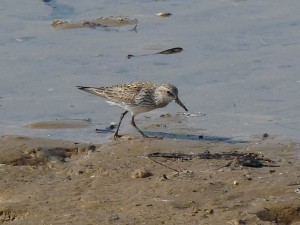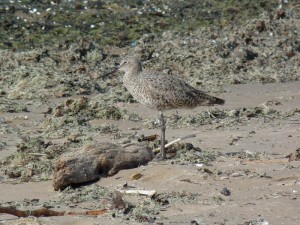In addition to a Willet, there were a couple White-rumped Sandpipers on Montrose Beach on my May 8 Big Day. The shorebirds I saw in the afternoon pushed my total to 103. White-rumped Sandpipers are uncommon but regular, mostly spring visitors to Montrose Beach. This bird posed obligingly while I took its photo.
Monthly Archives: May 2014
Willet, May 8, 2014
I had 13 species of shorebirds on my May 8 Big Day, which helped bump my total to over 100. My 100th bird was this Willet, which I saw when I went back out in the afternoon. Willets are uncommon but regular spring and summer visitors to Montrose Beach.
Montrose Big Day – 103 Species, May 8, 2014
I did a Big Day at Montrose on Thursday, May 8. This is the first Big Day I’ve ever done there. I’ve wanted to do a Montrose Big Day for a while but I either didn’t have the time or the weather wasn’t right. Today was different. I had the time and the weather cooperated. Last night’s south winds brought in a lot of birds, which is critical because doing a Big Day at Montrose depends almost entirely on migrants. I had no stake outs waiting for me, but there were a ton of migrants to work with. The only difference between today and any other day I bird Montrose is that today I 1) stayed longer and 2) paid close attention to every single bird I saw. I started at 5:30 a.m. and had to leave at 10 a.m. I went back out in the afternoon between 4 and 5 to check the beach for gulls and shorebirds. So I put in 5.5 hours, which is meager by Big Day standards. The area I covered included the beach, dunes, meadow, Magic Hedge, peripheral plantings, and east end of the harbor, and I walked between these areas. I ended up with 99 species in the morning and added 4 more in the afternoon for a total of 103. Here’s my list:
|
Canada Goose Wood Duck Mallard Blue-winged Teal Red-breasted Merganser Horned Grebe Double-crested Cormorant Great Blue Heron Green Heron Cooper’s Hawk Peregrine Falcon American Coot Black-bellied Plover Semipalmated Plover Killdeer Greater Yellowlegs Lesser Yellowlegs Willet Solitary Sandpiper Spotted Sandpiper Least Sandpiper Pectoral Sandpiper Dunlin White-rumped Sandpiper Semipalmated Sandpiper Herring Gull Ring-billed Gull Great Black-backed Gull Common Tern Caspian Tern Mourning Dove Chimney Swift Red-headed Woodpecker Yellow-bellied Sapsucker Downy Woodpecker Northern Flicker Eastern Wood-Pewee Least Flycatcher Eastern Phoebe Great Crested Flycatcher Eastern Kingbird White-eyed Vireo Warbling Vireo Blue Jay American Crow Purple Martin Bank Swallow Barn Swallow Northern Rough-winged Swallow Black-capped Chickadee House Wren |
Sedge Wren Ruby-crowned Kinglet Blue-gray Gnatcatcher Gray-cheeked Thrush Veery Swainson’s Thrush Wood Thrush American Robin Gray Catbird Brown Thrasher European Starling American Pipit Cedar Waxwing Blue-winged Warbler Orange-crowned Warbler Nashville Warbler Northern Parula Yellow Warbler Chestnut-sided Warbler Magnolia Warbler Yellow-rumped Warbler Black-throated Green Warbler Palm Warbler Black-and-white Warbler American Redstart Northern Waterthrush Ovenbird Canada Warbler Wilson’s Warbler Common Yellowthroat Eastern Towhee Field Sparrow Chipping Sparrow Clay-colored Sparrow Savannah Sparrow Lincoln’s Sparrow Swamp Sparrow Song Sparrow White-crowned Sparrow White-throated Sparrow Northern Cardinal Rose-breasted Grosbeak Indigo Bunting Bobolink Red-winged Blackbird Common Grackle Brown-headed Cowbird Baltimore Oriole House Finch Americn Goldfinch House Sparrow |
I had decent shorebirds for the day. Going back out in the afternoon actually pushed my total to 100, the Willet being #100. Passerines were fairly strong in general, especially sparrows, and especially White-crowned Sparrows. Catharus thrushes were well represented too. I ended up with 17 species of warblers and I had to work hard for most of them. None were abundant. Vireos were poorly represented and wrens weren’t much better. You always miss things on Big Days though. Still, I think 120 is possible at Montrose on an exceptionally good day in May.


